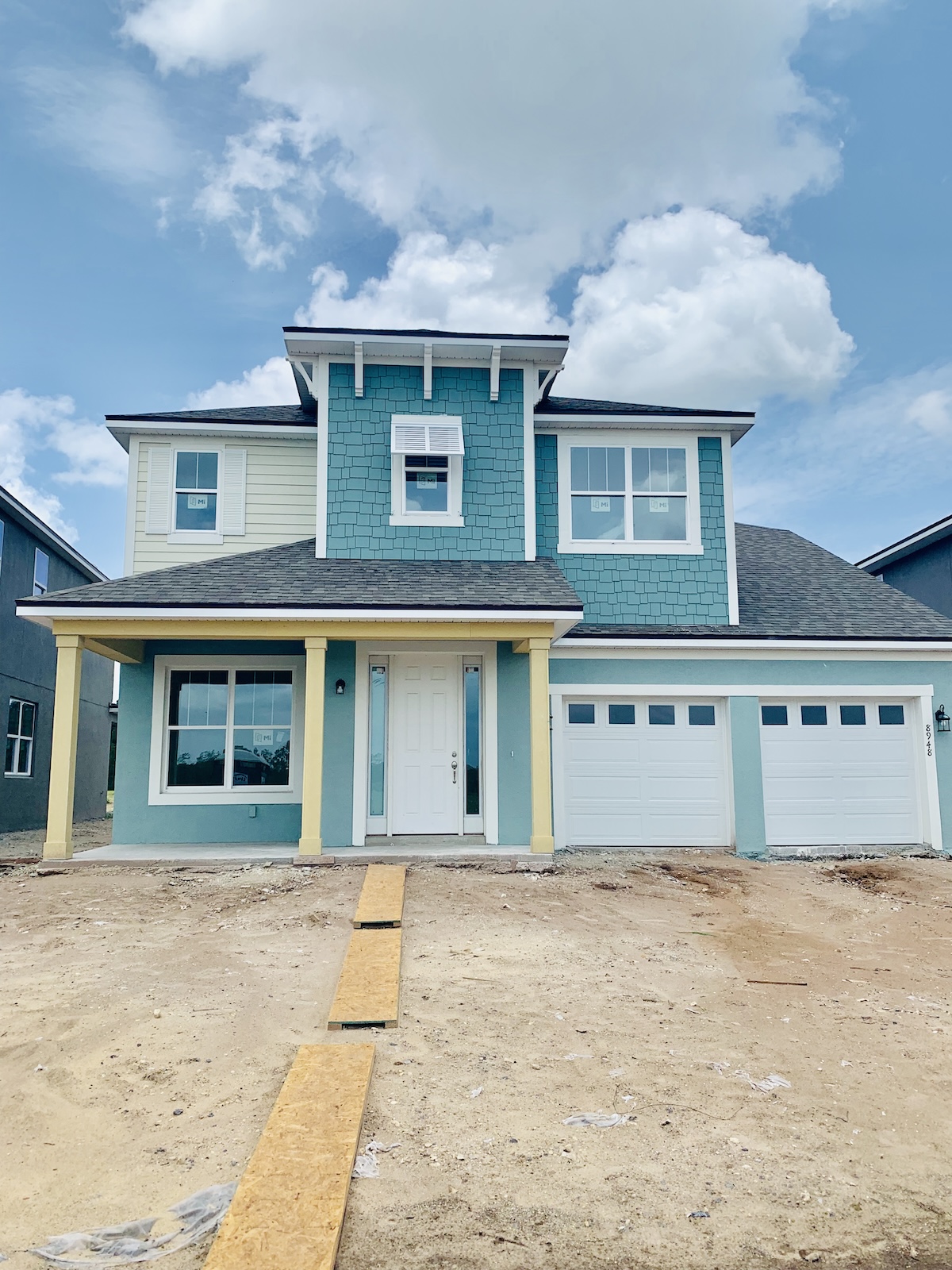Buying a new construction home can be a thrilling prospect. Think about it; you’re stepping into a space that’s never been lived in, one that may still smell of fresh paint and sawdust. You get to pick out the finishes, design elements, and perhaps even the layout if you get in early enough.
However, the financial process is a little different than buying a resale home, and it’s smart to know when your wallet will need to open.
Table of Contents
ToggleQuick Overview of the Payment Process

With new construction, you often pay in stages. The first check you’ll write is for the initial deposit once you sign the contract, which acts as a commitment to the build.
The full payment setup can vary, but many builders use a draw system that coincides with the completion of specific construction milestones.
Final payment is typically due at closing when the build is complete and you’re ready to take the keys.
It’s crucial to consider these pros and cons while you’re thinking about the payment schedule. After all, part of your budget should cover the unexpected – like a sudden need to pick the perfect doorknob when you didn’t even know you had a preference.
New Construction Payment Basics
When you’re eyeing a brand-new home, understanding how you’ll finance the construction is just as important as picking out your fixtures and finishes. You’ll navigate a few financial hoops before laying the first brick.
Initial Deposits and Payment Schedules
Down Payments: Typically, a builder will require an initial deposit to start construction on your new home. This could range from 5%,10% to 20% of the purchase price and Loan Preapproval type.
The payment schedule divides the rest of the home’s cost into segments, aligning with different construction milestones. Each builder will be different so it is important to have an advisor that can help navigate you through this part of the process.
Payment Schedule Example of a Custom Construction:
- Foundation Completion: 10% of purchase price
- Framing Completion: 10% of purchase price
- Lock-Up Stage: 10% of purchase price
- Finishing Touches: 10% of purchase price
- Final Walk-Through: Remaining balance
Construction Loans vs. Traditional Mortgages
- Construction Loans: A construction loan is specialized financing for building your new home. The key characteristic is its short-term nature — usually 12 months. During construction, you often pay just the interest on the disbursed amount.
- Traditional Mortgages: Contrastingly, a mortgage involves long-term financing for an already built home. With a mortgage, your repayment starts after possession and typically extends over many years.
Pre-Approval and Qualification Process
- Getting Pre-Approved: Before you pick up a hammer or choose a tile, get pre-approved. It’s your green light from a lender confirming how much they’ll finance.
To qualify, you’ll need to prove you can afford the down payment and subsequent mortgage payments. It’s a crucial step that pegs how expensive a home you can build.
The Role of Professionals in Your Purchase

When you’re buying a new construction home, two key players can majorly influence your experience: your real estate agent, loan officer, home builders or contractors you work with. They each bring unique expertise that will help you navigate the complexities of purchasing a constructed-from-scratch home.
Choosing the Right Real Estate Agent
When it comes to choosing a real estate agent, you want to ensure they’re experienced with new constructions. A seasoned agent will help navigate the details of contracts and negotiate with the builder on your behalf. Here’s what you should focus on:
- Expertise in New Construction: Seek an agent familiar with new builds and the specific challenges they present.
- Negotiation Skills: Your agent will negotiate terms, upgrades, and the final price with the home builder.
- Commission: Some home builders cover the agent’s commission. Custom home builders may include that in the price. Just make sure this transparent and included in your initial contract.
- National Association of Home Builders: Ensure your agent has good standing with professional bodies like this for extra peace of mind.
Working with Home Builders and Contractors
Building a relationship with a reputable builder and contractors is essential for a smooth home-buying experience. Their role in your purchase includes managing construction timelines and staying within budget. Keep these points in mind:
- Builder’s Reputation: Research the builder’s past work—look for quality, reliability, and customer satisfaction.
- Lender Approval: Some builders have preferred lenders, but always compare rates to ensure you’re getting the best deal.
- Contractors: High-quality contractors make a difference. See if they are recommended or certified by reputable entities.
- Communication: Clear communication with your builders and contractors will help you understand the process and set realistic expectations.
Timing and Milestones for Payments
When you’re getting your new construction home, payments are broken down into specific stages. You’ll be dealing with a few key milestones that determine when your wallet comes out, from the signing of your contract to the big day at closing.
Paying Upon Signing a Contract
Right off the bat, when you sign your contract, you’re going to put down some cash. This initial payment often ranges from 5%,10% to 20% of the purchase price. Think of it as your commitment to the deal.
Plus, if you’ve got some personalized upgrades in mind, this might be the time to pay for them, or at least a portion once design details have been selected.
Staged Payments During Construction
As your home takes shape, you’ll hit staged payments. These are based on construction milestones, and the timeline will be outlined in your agreement. Common stages might be:
- Foundation completion
- Framing completion
- Lock-up stage (When doors and windows are installed)
- Finishing touches
Each of these stages will have a due date for a specific payment amount, making it easy to plan your finances.
Finalizing Payments at Closing
Finally, when you’re ready to get the keys, your remaining balance is due at closing. This includes not just the last chunk of the home’s price but also any relevant closing costs.
Your closing date will be in your contract, so you’ll know way in advance to get your funds ready for the big finale.
Budget Considerations When Planning for Payments
When you’re gearing up to pay for your new construction home, you’ve got some budgeting to do. It’s not just about the sticker price; you’ll need to think of the whole financial picture, including initial investments, potential surprises, and the day-to-day costs down the road.
Evaluating Upfront and Long-Term Costs
- Down Payment: Expect to shell out a down payment of around 10-20% of the home’s value.
- Construction Phases: You’ll typically pay the builder in intervals as construction progresses.
- Loan Amount: The remaining balance of your home’s cost converts to your mortgage loan upon completion.
Managing Unexpected Costs
- Budget Padding: Set aside a buffer—usually 10-15% of your budget—for unexpected costs. Some examples of unexpected costs include material price hikes, delays, and upgrades or alterations to the original plan.
Homeowners Association and Ongoing Costs
Homeowners Association (HOA) Fees: If applicable, include monthly or yearly HOA dues in your budget.
Maintenance: Factor in costs for areas like:
- Landscaping: Ongoing professional services or equipment and supplies if you DIY.
- Repairs: Funds for fixes that pop up along the way.
Navigating Loan Options and Mortgage Rates
When you’re in the market for a new construction home, the choices of loans can be a bit overwhelming. You’ll encounter different lenders offering a range of financing options. It’s crucial to compare these to find what works best for your financial situation.
It’s important to lock in your interest rates as they can fluctuate. A locked rate could protect you from any increases during the construction period. Some lenders allow you to extend the rate lock for a fee, often around 0.45% of the loan amount.
This could be worth considering if you believe rates might rise.
Here’s a quick glance at what you might expect. Please refer to your licensed bank or mortgage professional to provide clarity on all financing.
- Conventional Mortgage: May have a higher down payment
- FHA 203k: Lower down payment
When it’s time to choose your mortgage lender, ask about all associated costs and compare these across different lenders to ensure you get the best deal.


